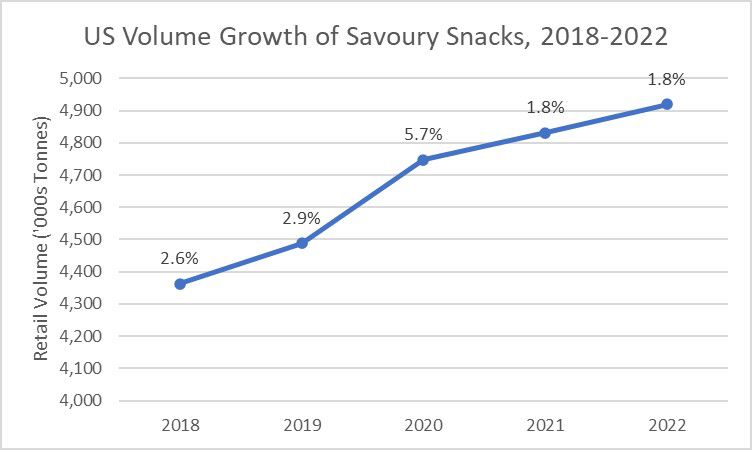The National Restaurant Association (NRA) Show took place in Chicago from 21-24 May 2022. As the foodservice industry recovers from the challenges of the pandemic, companies are focused on innovation to drive business. The show hosted attendees from around the world and featured the latest developments in food, drinks, packaging, and technology for the restaurant industry. Euromonitor International analysts attending the show observed several key trends driving innovation.
New textures and flavours in savoury snacks
Popular indulgent snacks such as potato chips performed incredibly well in 2020, but decelerated after pandemic stress and isolation waned, consumers focused on healthy eating, and snacking occasions shifted. In the US, the staple potato chip does not always meet evolving consumer preferences. To appeal to and retain consumers, manufacturers are innovating with intriguing textures and flavours and elevating classic brands or creating new products altogether to attract their attention.

Source: Euromonitor International
One new product discussed at the NRA was Frito-Lay’s Lay’s Layers, a distinctively airy, crispy, and swirly twist on the traditional Lay’s potato chip, available in two flavours. Nationwide distribution began in January and has earned attention from exploratory consumers. Large manufacturers are not the only innovators, however. A small New England-based company called Deep River, known locally as the Ben and Jerry’s of chips for its unique flavour varieties, was another notable name. On display at the NRA were varieties such as Sweet Maui Onion, New York Spicy Dill Pickle, and Argentinian Chimichurri, flavours not commonly seen in the snack aisle. Currently distributing nationally, though on a limited scale, flavours such as these offer consumers the unique snacking experiences they are looking for. Companies of all sizes are developing new products aimed at sparking curiosity and enhancing consumers’ snacking experiences through flavour and texture. There is no doubt that this is the direction savoury snacks are moving in, and customers are ready to explore these new options.
Continued rise of plant-based alternatives
Plant-based alternatives continue to grow, with a particular focus on seafood, chicken, and dairy. Several companies exhibited their new plant-based tuna options, including Finless Foods and PlanTuna. Good Catch Seafood, a seafood alternative company with several offerings such as plant-based fish sticks and crab cakes, offered samples of its products, which are available in both retail and foodservice. Plant-based chicken was also big at the show. Tindle is a new offering from Next Gen Foods, a food-tech start-up based in Singapore that produces plant-based meat products. It offers soy-based chicken alternatives with 17 grams of protein, aiming to provide the same nutritional benefits as traditional chicken. Other companies advertising their plant-based chicken products included Daring and MorningStar. Plant-based seafood and chicken have historically seen lower levels of innovation than other meats such as beef, and many new companies are entering the space as they begin to gain traction.
Dairy alternatives were also prominent at the show. Plant-based ice cream has been one of the fastest growing packaged food categories, increasing by 23% in 2021. Ripple Foods debuted its vegan soft serve base, which won an NRA Food and Beverage award for its “superior taste and potential to revolutionize food and beverage”. Plant-based is expected to remain an important trend as companies continue to improve on taste, texture, and appearance of alternatives.
Automation in foodservice
The face of consumer foodservice is changing and becoming increasingly faceless with the emergence of technology, reducing human interaction with food. COVID-19 has made consumers more aware of diseases and hygiene, whilst also plaguing the restaurant industry with a labour issue that is still ongoing. The automation of processes reduces potential spread of bacteria from humans as well as standardising cooking processes. Restaurant owners are responding with interest as they look to control the food process and eliminate the variability of labour. The NRA unveiled equipment capable of automatic frying, assembling, baking, and even sushi making. The robotics along with automation of other processes such as ordering, delivery, and restaurant management, all incorporating the latest AI developments, were on full display at the NRA, pointing to a future where technology drives foodservice.
Looking ahead to Generation Z
There was no lack of creativity at the NRA but behind a lot of the buzz words, innovative flavours, and unique textures was one driving force – Generation Z. The Gen Z consumer base is expanding rapidly, and the audience has generated its own form of marketing via social media. This generation of consumers has proven to be trendsetters and companies are responding. Looking at Coca-Cola for instance, the launch of its Agua Frescas line was an attempt to appeal to the Gen Z consumer searching for exotic flavours – it might just be mango juice but now it has become “Mango Agua Frescas,” that is deemed fashionable. Therefore, companies will seek to diversify their flavour portfolios in an effort to appeal to the new face of the market.


